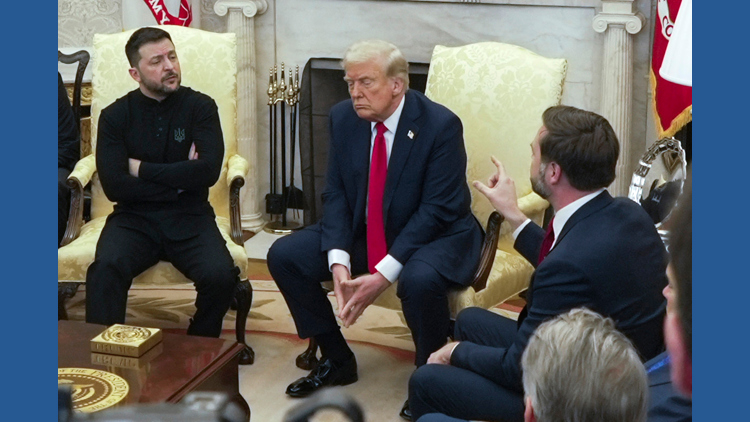President Donald Trump has unveiled a new 28-point plan aimed at resolving the ongoing conflict in Ukraine, asserting that Ukrainian President Volodymyr Zelenskyy lacks the leverage to continue fighting and must consider a settlement favoring Russia. Trump stated that he expects Zelenskyy to respond to this proposal by January 4, 2024. “We think we have a way of getting peace,” Trump said during a press conference at the White House. “He’s going to have to approve it.”
Zelenskyy is facing immense pressure as he navigates a challenging political landscape marked by a corruption scandal involving $100 million in kickbacks related to contracts with the state-owned nuclear energy company. This situation has prompted resignations of several high-ranking officials within his government. Amid ongoing Russian assaults on Ukraine’s energy infrastructure, Zelenskyy acknowledged that the country is confronting a crucial decision that could define its future.
The relationship between Trump and Zelenskyy has been fraught with tension since their first conversation in 2019, which resulted in Trump’s first impeachment due to allegations that he sought to pressure Zelenskyy into investigating political rival Joe Biden. Their interactions have been marked by challenging discussions, including a recent contentious meeting where Trump criticized Zelenskyy for perceived ingratitude regarding the more than $180 billion in U.S. military aid and support provided since the onset of the war.
Despite the historical context, Trump’s latest plan, presented in Kyiv by U.S. Army Secretary Dan Driscoll, has generated apprehension. The proposal reportedly includes significant concessions, such as ceding control of the eastern Donbas region to Russia and reducing the size of Ukraine’s military. Analysts from the Institute for the Study of War estimate that complete Russian control over the Donbas could take years, yet Trump insists that Ukraine will inevitably lose territory.
Zelenskyy articulated the gravity of the situation in a video address, stating, “Now Ukraine may find itself facing a very difficult choice: either loss of dignity or the risk of losing a key partner.” The Ukrainian leader has not yet spoken with Trump following the unveiling of the proposal, but he anticipates a conversation within days.
The Trump administration has framed the plan as a pragmatic approach to the realities on the ground, suggesting it offers a “win-win scenario” for both Ukraine and Russia. White House Press Secretary Karoline Leavitt emphasized that the proposal is intended to reflect the current dynamics of the situation. Nonetheless, it remains uncertain how much time Trump is willing to allocate for negotiations.
Political analysts have commented on Trump’s strategy, noting that he appears to have identified vulnerabilities within Zelenskyy’s position. Konstantin Sonin, a political economist at the University of Chicago, remarked that Trump is adept at recognizing weaknesses and that Zelenskyy’s government could be at risk if he agrees to the U.S. terms.
The proposed plan also includes stipulations that may be seen as undermining Ukrainian sovereignty. For instance, one provision calls for both Ukraine and Russia to abolish “all discriminatory measures” while guaranteeing media and educational rights for both nations. Such demands could be perceived as validating Russian narratives that have justified the invasion.
As winter approaches, Ukraine’s military faces mounting challenges, including relentless aerial assaults that have caused widespread blackouts. The uncertainty surrounding future financial support from Europe, which hinges on loans linked to frozen Russian assets, further complicates the situation for Ukrainian officials.
Trump’s approach to negotiations could significantly reshape the power dynamics in the region. Many observers question whether Zelenskyy can accept the proposed concessions without facing backlash from his constituents. David Silbey, a military historian at Cornell University, suggested that the plan risks eroding Ukrainian public trust and national pride.
The unfolding events highlight the delicate balance Zelenskyy must maintain as he weighs Trump’s proposals against the backdrop of ongoing conflict and internal pressures. The coming days could be pivotal for Ukraine as it navigates its most challenging decision in recent history.
